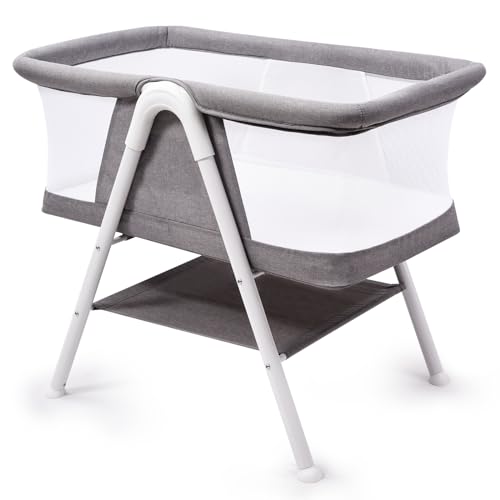Bedside Cosleeper
A bedside cosleeper attaches to your adult bed. It's safe, so long as you adhere to the CSPC safety guidelines for infant sleep spaces.
These guidelines are similar to crib bedding standards. Learn more about the guidelines here. When choosing a bedside sleeping device safety, comfort, and ease of use are the primary aspects to take into consideration.

Safety
In accordance with the American Academy of Pediatrics' recommendation that infants sleep in the same bed as their parents, cosleeping (a practice also referred to as bed-sharing) has become popular among many expecting and new parents. The Academy says that sharing a room with a baby is more secure than sleeping in the same bed as a parent because it reduces the chance of Sudden Unexpected Infant Death (SIDS). The AAP doesn't recommend bed sharing however, it does recommend that co-sleeping on a separate sleeping surface is a great way to reduce the risk of SIDS. The development of the bedside crib was crucial for a lot of families.
A bedside cosleeper is a crib-like sleeper that can be attached to an adult bed frame. The bedside cosleeper allows parents to monitor the baby and gives them the freedom to sleep in their own bed. The best cosleepers have strict safety standards and are constructed with durable, high-quality components. To ensure the safety of your child be sure to look for the Juvenile Products Manufacturers Association stamp of approval. This confirms rigorous testing and quality control.
The security of a cosleeper for the bed depends on several aspects that include the manner in which it is put up and secured to the parent's bed. It is important that the bedside sleeper be secured to the mattress of the parent in a manner that prevents gaps and spaces, where an infant could become trapped. This could result in an entrapment risk. It is vital that the attachment system used for the bedside sleeper is tested to ensure that it can withstand any forces that are applied during use, for example the parent moving on and off the sleeper. The attachment system, or the corners on the bedside cosleeper should be subjected to a horizontal force.
The voluntary standard for bedside sleepers includes by reference the federal consumer safety standard for products such as bassinets and cradles (16 CFR part 1218) that includes requirements for the performance of fabric-sided enclosed openings. The standard's requirements for mandatory compliance address the danger of head and neck entrapment by requiring that, after the application, release 50 lbs. The standard also stipulates that following the release and application of 50-lb. It is not permitted to create a gap larger than 1.0 in. ASTM's electronic Reading Room offers read-only versions of the standard.
Convenience
While many parents have avoided cosleeping because of fears of suffocation SIDS or the "Ferberization" process that makes children to be in a room by themselves Anthropologists have long observed that most primates and mammals, as well as people living in non-Western societies, frequently coslept. It could be because infants are comforted by the familiar voice of their mother and it may also help to practice self-soothing.
The best bedside sleepers feature clever design that can be attached to the side of any bed and swivels for easy access for feedings during the night or diaper changes. Choose a model that has adjustable feet that retract to accommodate various mattress sizes. It should also include an ample storage area to store everything your baby needs.
Choose a bedside crib that fits the standard crib bedding, so that it will be safe to use as your child grows. Think about a model that's convertible and can be used as a play yard or a bassinet that is deeper. bedside crib or cot www.cots4tots.co.uk can last for many years.
Portability
Based on the size of your bedroom a bedside sleeper with wheels and/or a lightweight base could be easier to move around the house than one that has a heavy wood frame or substantial base. The babybay bedside sleeper, HALO bassiNest essencetia, as well as Snoo Smart Sleeper are all portable. They come with adjustable feet that retract to accommodate platform mattresses and legs that fold inwards to provide maximum access to the mattress; 100 mesh sidewalls that allow ventilation without fabric covering baby's nose or mouth.
The Arm's Reach ClearVue is another popular option that adjusts in 1" increments to fit most adult beds and can also be used as a portable bassinet. It also swivels to allow the baby to be easily accessible so that you can soothe your baby, nurse or monitor her at night.
